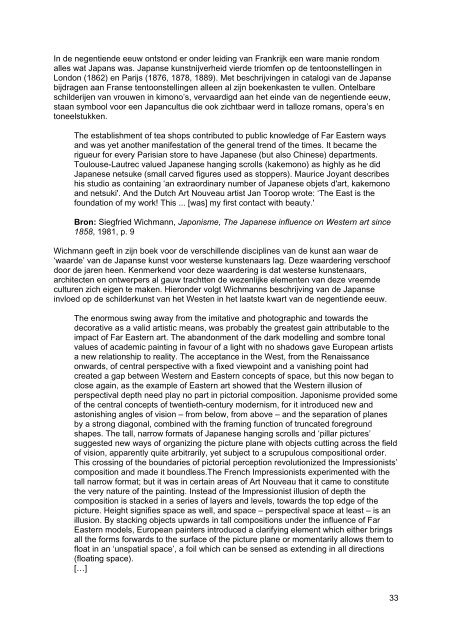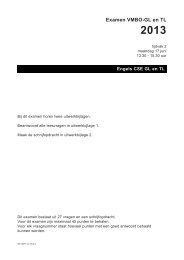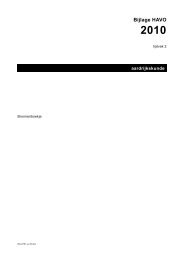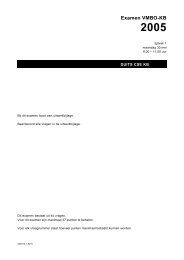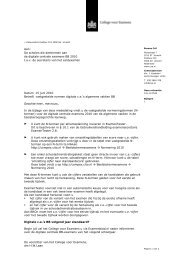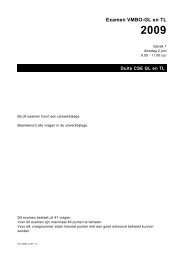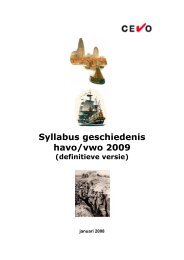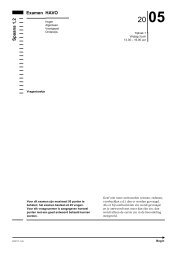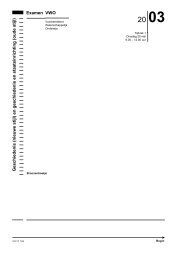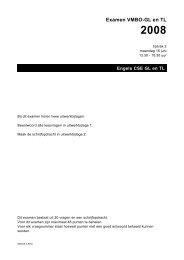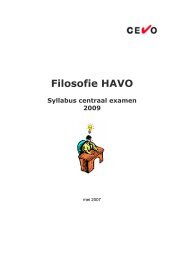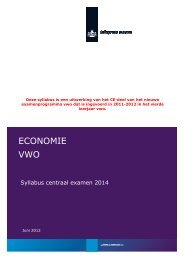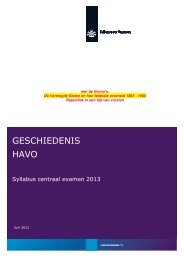Generieke en specifieke teksten cse 2012, vwo - Examenblad.nl
Generieke en specifieke teksten cse 2012, vwo - Examenblad.nl
Generieke en specifieke teksten cse 2012, vwo - Examenblad.nl
Create successful ePaper yourself
Turn your PDF publications into a flip-book with our unique Google optimized e-Paper software.
In de neg<strong>en</strong>ti<strong>en</strong>de eeuw ontstond er onder leiding van Frankrijk e<strong>en</strong> ware manie rondom<br />
alles wat Japans was. Japanse kunstnijverheid vierde triomf<strong>en</strong> op de t<strong>en</strong>toonstelling<strong>en</strong> in<br />
London (1862) <strong>en</strong> Parijs (1876, 1878, 1889). Met beschrijving<strong>en</strong> in catalogi van de Japanse<br />
bijdrag<strong>en</strong> aan Franse t<strong>en</strong>toonstelling<strong>en</strong> alle<strong>en</strong> al zijn boek<strong>en</strong>kast<strong>en</strong> te vull<strong>en</strong>. Ontelbare<br />
schilderij<strong>en</strong> van vrouw<strong>en</strong> in kimono’s, vervaardigd aan het einde van de neg<strong>en</strong>ti<strong>en</strong>de eeuw,<br />
staan symbool voor e<strong>en</strong> Japancultus die ook zichtbaar werd in talloze romans, opera’s <strong>en</strong><br />
toneelstukk<strong>en</strong>.<br />
The establishm<strong>en</strong>t of tea shops contributed to public knowledge of Far Eastern ways<br />
and was yet another manifestation of the g<strong>en</strong>eral tr<strong>en</strong>d of the times. It became the<br />
rigueur for every Parisian store to have Japanese (but also Chinese) departm<strong>en</strong>ts.<br />
Toulouse-Lautrec valued Japanese hanging scrolls (kakemono) as highly as he did<br />
Japanese netsuke (small carved figures used as stoppers). Maurice Joyant describes<br />
his studio as containing ‘an extraordinary number of Japanese objets d'art, kakemono<br />
and netsuki'. And the Dutch Art Nouveau artist Jan Toorop wrote: ‘The East is the<br />
foundation of my work! This ... [was] my first contact with beauty.'<br />
Bron: Siegfried Wichmann, Japonisme, The Japanese influ<strong>en</strong>ce on Western art since<br />
1858, 1981, p. 9<br />
Wichmann geeft in zijn boek voor de verschill<strong>en</strong>de disciplines van de kunst aan waar de<br />
‘waarde’ van de Japanse kunst voor westerse kunst<strong>en</strong>aars lag. Deze waardering verschoof<br />
door de jar<strong>en</strong> he<strong>en</strong>. K<strong>en</strong>merk<strong>en</strong>d voor deze waardering is dat westerse kunst<strong>en</strong>aars,<br />
architect<strong>en</strong> <strong>en</strong> ontwerpers al gauw trachtt<strong>en</strong> de wez<strong>en</strong>lijke elem<strong>en</strong>t<strong>en</strong> van deze vreemde<br />
cultur<strong>en</strong> zich eig<strong>en</strong> te mak<strong>en</strong>. Hieronder volgt Wichmanns beschrijving van de Japanse<br />
invloed op de schilderkunst van het West<strong>en</strong> in het laatste kwart van de neg<strong>en</strong>ti<strong>en</strong>de eeuw.<br />
The <strong>en</strong>ormous swing away from the imitative and photographic and towards the<br />
decorative as a valid artistic means, was probably the greatest gain attributable to the<br />
impact of Far Eastern art. The abandonm<strong>en</strong>t of the dark modelling and sombre tonal<br />
values of academic painting in favour of a light with no shadows gave European artists<br />
a new relationship to reality. The acceptance in the West, from the R<strong>en</strong>aissance<br />
onwards, of c<strong>en</strong>tral perspective with a fixed viewpoint and a vanishing point had<br />
created a gap betwe<strong>en</strong> Western and Eastern concepts of space, but this now began to<br />
close again, as the example of Eastern art showed that the Western illusion of<br />
perspectival depth need play no part in pictorial composition. Japonisme provided some<br />
of the c<strong>en</strong>tral concepts of tw<strong>en</strong>tieth-c<strong>en</strong>tury modernism, for it introduced new and<br />
astonishing angles of vision – from below, from above – and the separation of planes<br />
by a strong diagonal, combined with the framing function of truncated foreground<br />
shapes. The tall, narrow formats of Japanese hanging scrolls and ‘pillar pictures’<br />
suggested new ways of organizing the picture plane with objects cutting across the field<br />
of vision, appar<strong>en</strong>tly quite arbitrarily, yet subject to a scrupulous compositional order.<br />
This crossing of the boundaries of pictorial perception revolutionized the Impressionists’<br />
composition and made it boundless.The Fr<strong>en</strong>ch Impressionists experim<strong>en</strong>ted with the<br />
tall narrow format; but it was in certain areas of Art Nouveau that it came to constitute<br />
the very nature of the painting. Instead of the Impressionist illusion of depth the<br />
composition is stacked in a series of layers and levels, towards the top edge of the<br />
picture. Height signifies space as well, and space – perspectival space at least – is an<br />
illusion. By stacking objects upwards in tall compositions under the influ<strong>en</strong>ce of Far<br />
Eastern models, European painters introduced a clarifying elem<strong>en</strong>t which either brings<br />
all the forms forwards to the surface of the picture plane or mom<strong>en</strong>tarily allows them to<br />
float in an ‘unspatial space’, a foil which can be s<strong>en</strong>sed as ext<strong>en</strong>ding in all directions<br />
(floating space).<br />
[…]<br />
33


